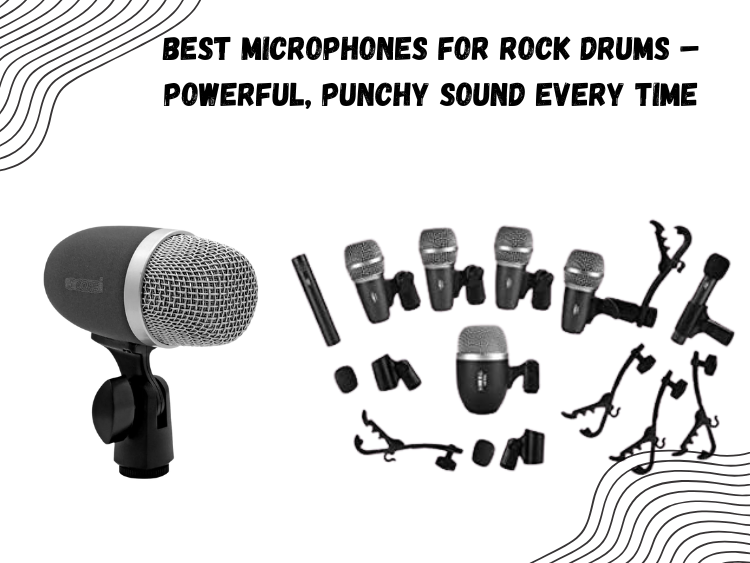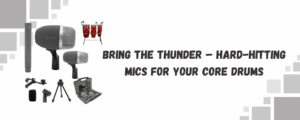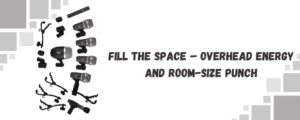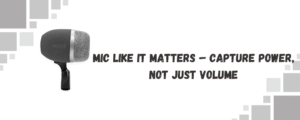When it comes to recording or performing with a rock kit, subtlety isn’t the goal—impact is. You want every snare hit to crack through the mix, every kick to punch you in the chest, and every tom roll to feel like a wave crashing down. That kind of power doesn’t happen by accident. It starts with the right mics.
The best rock drum mics don’t just pick up sound—they shape it. They handle high SPLs, emphasize attack, and preserve that raw, aggressive energy that defines the genre. Whether you’re building a home studio setup or gearing up for live gigs, here’s how to choose the right tools for a punchy drum sound every single time.
Kick Drum – Go Big or Go Home
Rock kick drums aren’t shy. They’re the backbone of the groove, and they need a mic that can capture low-end weight and upper-mid bite—without folding under pressure.
A dedicated kick drum mic, like the Audix D6 or Shure Beta 52A, is built for exactly this. But for a more flexible solution that still hits hard, the 5 Core dynamic drum mic delivers serious low-end clarity with enough snap to cut through even dense guitar-heavy mixes.
Placement tip: Stick it just inside the port hole (if there is one), angled toward the beater for attack. If your kick’s sealed, go just outside the head and aim dead center. Move back an inch or two to pull in more body and boom.
Snare – Snap, Crack, and Pop
If the kick is the heart of rock drumming, the snare is the voice. It has to be loud, crisp, and aggressive—without turning into white noise.
A standard workhorse like the SM57 is always solid, but a tighter, hotter dynamic capsule can bring out more transient detail and body. That’s where the 5 Core snare/tom mic earns its keep. It handles loud snares with ease and captures the kind of sharp, defined attack you need for rock.
Placement tip: Angle it about 2–3 inches from the head, aimed slightly off-center to avoid harsh overtones. Want more crack? Move closer. Want more body? Pull back a bit and capture some shell tone.
Toms – Full, Fat, and Thunderous
Rock toms aren’t background instruments—they’re featured players. And when they roll in, they need to move air.
Use dynamic mics that accentuate low mids and can handle high SPLs without distortion. Clip-on mounts make positioning easy, and here again, the 5 Core tom/snare mic is a solid pick. It’s voiced to bring out the deep boom of floor toms and the punchy slap of rack toms without sounding muddy or boxy.
Placement tip: About an inch or two above the rim, angled toward the center. For more attack, move closer. For rounder tone, shift off-axis or back it up slightly.
Overheads – Not Just for Cymbals
In rock, overheads do more than just catch cymbals—they fill in the gaps. A pair of bright condensers placed high above the kit adds energy, space, and sheen to the sound.
But here’s the thing: you don’t want them too soft. Jazz overheads are subtle. Rock overheads need presence.
Go for a matched pair of condensers with strong top-end response and good off-axis rejection. A setup like the Rode NT5 pair is clean, but if you’re looking for more versatility, even the 5 Core kit mics pull double duty here—especially in tighter rooms where bleed is less of an issue.
Placement tip: A spaced pair 3–4 feet above the cymbals works well. ORTF is another solid choice if you’re going for tighter stereo imaging. Just watch your phase.
Hi-Hats – Optional, But Handy
Hi-hats in rock are often loud enough to bleed into everything. So, do you even need a dedicated mic?
Only if the part demands clarity—fast 16th note grooves, open/close articulation, or offbeat textures. If that’s the case, use a small diaphragm condenser a few inches above the top hat, aimed down but slightly off-axis to reduce harshness.
Again, if you’re using a kit like this one from 5 Core, you’ve got what you need. The included condensers have enough detail to handle cymbals cleanly without overshooting.
Room Mics – Glue It All Together
If you’ve got the luxury of a good-sounding space, don’t skip this step. Room mics add size, depth, and realism. A stereo pair, or even a mono condenser 6–10 feet out front, can take a raw drum mix from tight to cinematic in one fader move.
Room mics are where you dial in vibe. Want Bonham-style hugeness? Slam them with compression. Want arena rock? Add a splash of plate reverb and push them up behind the close mics.
This is where the Sennheiser e 914 or a comparable condenser—shines. These are detailed and airy without being too clinical. And when pushed, they sound massive.
Final Word
You can tune your drums, practice your parts, and play your heart out—but if the mics don’t match the energy, it won’t translate. Rock drums need definition, punch, and attitude—and that starts at the capsule.
The 5 Core dynamic drum kit hits all the right marks. It’s built to handle aggressive playing, delivers clean attack, and doesn’t choke your tone. If you’re after a punchy drum sound that slams every time, this is your workhorse.
Because in rock, if the drums don’t hit hard, nothing else matters.




